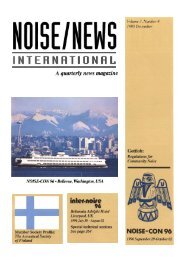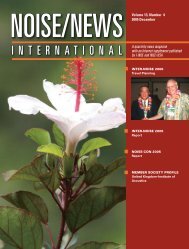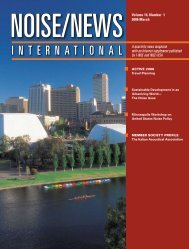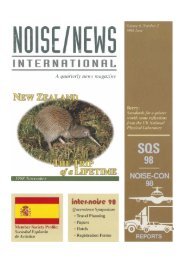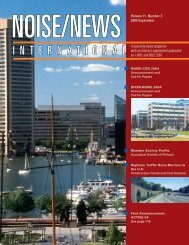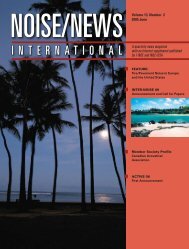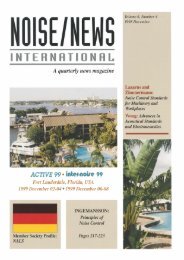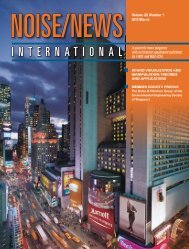Volume 15, Number 4, December, 2007 - Noise News International
Volume 15, Number 4, December, 2007 - Noise News International
Volume 15, Number 4, December, 2007 - Noise News International
- No tags were found...
You also want an ePaper? Increase the reach of your titles
YUMPU automatically turns print PDFs into web optimized ePapers that Google loves.
Policy Laws and Rules Years References RemarksEnvironmental Policy for <strong>Noise</strong> Basic Law for the Environmental Policy 1983 Environmental Standards Framework LawIndustrial <strong>Noise</strong> and Vibration Regulatory Law for <strong>Noise</strong> and Vibration 1983 Allowed Emission LimitConstruction <strong>Noise</strong> and Vibration Regulatory Law for <strong>Noise</strong> and Vibration 1983 Regulatory LimitNew and Used Vehicle <strong>Noise</strong> Regulatory Law for <strong>Noise</strong> and Vibration 1985 Allowed Emission LimitRoad Traffic <strong>Noise</strong> Regulatory Law for <strong>Noise</strong> and Vibration 1983 Allowed RangeAirport <strong>Noise</strong> Regulatory Law for <strong>Noise</strong> and Vibration 1994 Allowed Range 1988 OlympicsRailroad <strong>Noise</strong> Regulatory Law for <strong>Noise</strong> and Vibration 1999 Allowed Range High-speed TrainsProduct <strong>Noise</strong> Rating Regulatory Law for <strong>Noise</strong> and Vibration 1993 Mandatory for Construction Equipment onlyTable 2. <strong>Noise</strong> Policy and Related Laws in Chronological Orderany case, violation of the Limit mayincur penalties and disadvantages asprescribed in the Law.• <strong>Noise</strong> Range is applied in certaindesignated areas by the central or localgovernments for road traffic noise,railroad noise, and airport noise. Whilethe <strong>Noise</strong> Limit was intended to controlindividual sources such as industrialmachinery and vehicles, the <strong>Noise</strong>Range protects areas from traffic noise.Because the <strong>Noise</strong> Range deals withtraffic noise and is applied to areas, nopenalty is imposed for failure to observeit. Still, the central or local governmentmust take action, either legal oradministrative, to protect the designatedzone from noise and publish the resultsperiodically for public review.• Product <strong>Noise</strong> Rating aims to providethe consumer with a means for selectingquieter products. It was initiallyintended to apply to home appliances,but there was strong opposition fromthe electronics manufacturers. As aresult, the Product <strong>Noise</strong> Rating isjust a recommendation for consumerproducts but is mandatory when appliedto construction equipment. By lawthis equipment, both domesticallymanufactured and imported, must carrythe <strong>Noise</strong> Rating Tag.Conclusions<strong>Noise</strong> policy in Korea has evolved duringthe past 20 years, making it very systematicand comprehensive. The members of thepanel which assisted the government indeveloping various noise policies remainedalmost unchanged during that period. Thisenabled the panel to develop the policyin a very systematic and consistent way,minimizing conflicting factors amongdifferent policies and evaluating theworkability of the policy.As a late starter, Korea learned somevaluable lessons from the experienceof advanced countries, and adjusted itspolicy goals and implementation schemesaccordingly. Although the Koreanexperience may be unique and may not bereadily applied to other countries, the spiritmay be shared. Also, the principles setup during the course of establishing noisepolicy in Korea may be observed withequal validity by any nation that wishes toestablish its own noise policy.Progress towardacoustical reformof AmericanschoolsDavid Lubman, FASA,Westminster, CA 92683(This presentation is in the form ofquestions and answers.—Ed.)What progress has been made in schoolacoustical reform in the United States?American National Standards Institute(ANSI) Standard S12.60-2002 hasspecified acoustical performance criteria,design requirements, and guidelines forschools. Acoustical reform in schoolsis supported by the U. S. Access Board(Americans with Disabilities Act) andmany other professional organizations. Itis endorsed by the National Academy ofSciences National Research Council for“green” school buildings (2006), and hasbeen adopted by several states.Many of ANSI’s initial opponents in theHVAC and relocatable classroom industrieshave been won over; new, quieter productsare being developed for the school market.Weakened versions of S12.60 have beenadopted by CHPS (Collaborative forHigh Performance Schools) in Californiaand elsewhere, and CHPS stimulated adraft for Green Building Council’s LEEDguideline for green schools with CHPSlikeacoustical requirements (August-September 2006).How did the new policies come about?This began around 1997 with twoindependent actions:1. A populist uprising by AcousticalSociety of America (ASA) activiststo improve classroom acoustics wasfostered by a visionary acousticalconsultant, Buzz Towne. ASAsupported classroom acoustics activitiesthrough its Technical Committees(Architecture, Acoustics, <strong>Noise</strong>, andSpeech Communication. At the same<strong>2007</strong> <strong>December</strong> www.inceusa.org • www.noisenewsinternational.net • www.i-ince.org141



